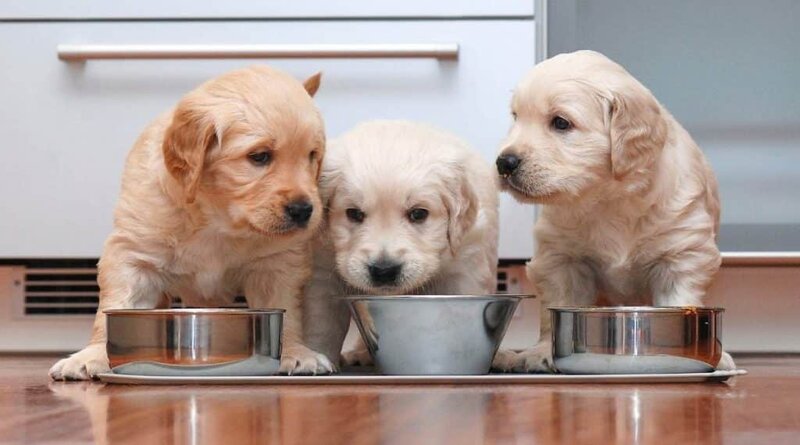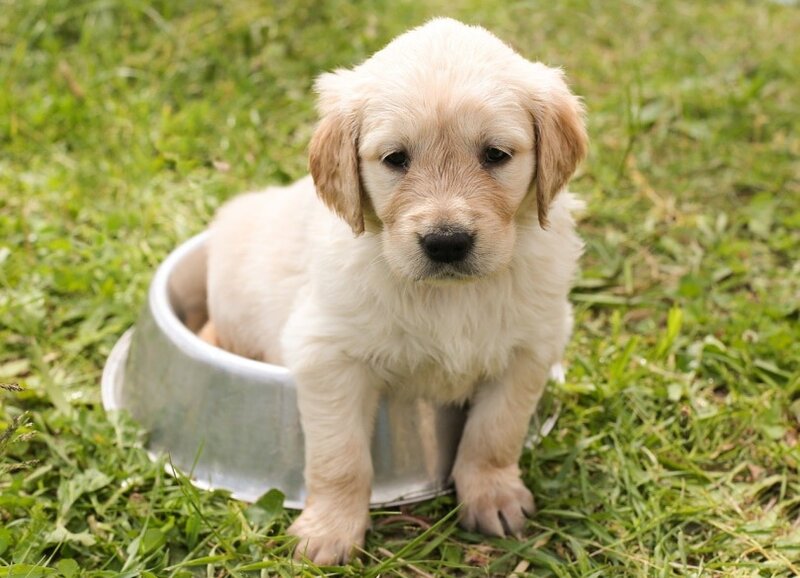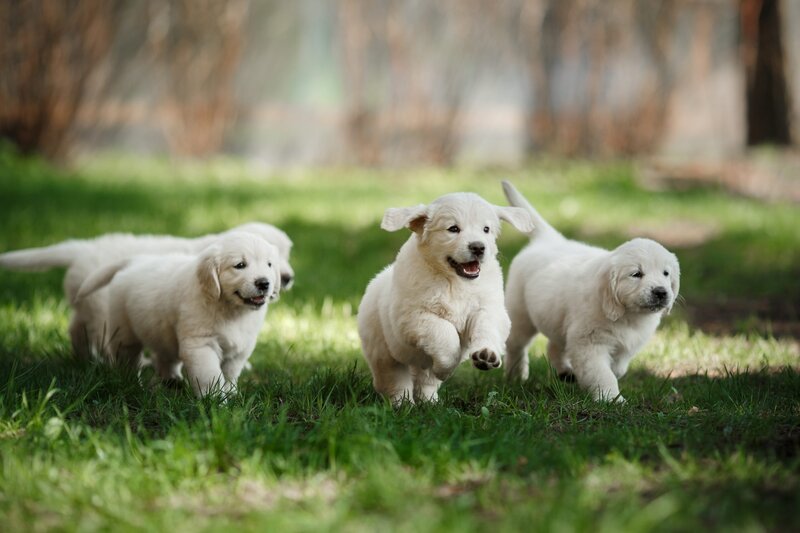Golden retriever puppies will eat everything they want if left alone. In truth, golden retrievers are generally good eaters who will eat whatever they find. To keep your dog in good health, provide it with a high-quality diet and make sure it eats enough without overdoing. In this guide, we will give you a recommended chart for the amount of food for golden retriever puppies and some tips on how to feed them easily.

How Much Food For Golden Retriever Puppy?
The amount of food to feed a golden retriever puppy will vary depending on its age and size. Your veterinarian can advise you on the best food for a golden retriever puppy and quantities for your dog. A golden retriever puppy around 7 weeks old will typically take between a third and a half cups of dry puppy chow per meal. Always remember to have water provided at all meals.
Presented herein is a feeding chart for a golden retriever puppy:
| Age | Gender | Amount Of Food (cups/ day) | Number of Meals per Day (Divide the cups/day by the number of feedings per day) |
| 2 Months | Male & Female | 1½ | 3 |
| 3 Months | Male & Female | 2 | 3 |
| 4 Months | Male & Female | 2½ | 3 |
| 5 – 6 Months | Male & Female | 3 | 3 |
| 6 – 7 Months | Male | 3½ to 4 | 2 |
| Female | 3 | 2 |
Note that this is a general chart and you need to base it on the real age, size, and health of your puppy to feed them properly.
Because puppies have larger energy demands but smaller stomachs, you will need to use a golden retriever puppy feeding chart. With the proper feeding plan, your puppy can develop and grow normally without being unduly hungry at any time during the day.
You need to feed your golden retriever puppy 3 times per day at regular intervals until it is six months old. Your puppy should eat breakfast, noon, and dinner, and you can devise a feeding schedule depending on your daily schedule and job obligations. When your puppy reaches 6 months of age, you may begin feeding them twice per day, but you should maintain them on food for puppies until they hit adulthood.
How to Know You’re Feeding Your Golden Retriever Puppy Enough

If your golden got his way, he’d probably eat all day. However, puppies must be fed on a regular schedule to avoid overeating and growing overweight.
How can you determine if your puppy is eating enough? Below are some indications that your Golden Retriever puppy is well-fed:
- He’s Growing at a Consistent Rate: Throughout the first six months of life, your Golden Retriever puppy should gain roughly five pounds per month. Later, their development will begin to slow.
- He Got a Healthy Appetite: A healthy puppy enjoys eating and is eager for food. If your puppy runs away from his food or seems not to be interested in eating, it might be an indication that he doesn’t feel well, and you need to bring him to the veterinarian.
- He Seems Trim and Muscular: You need to be able to feel your puppy’s ribs, but they should not protrude. If you cannot feel them anyhow, your dog is likely overweight. If you look at them, you will see that he most likely lacks nutrients.
- He Has Lots of Energy: A well-fed puppy is energetic and eager to play. If your dog is lethargic, it could indicate that he isn’t receiving enough to eat.
- Good eyes, coat, and skin: A well-fed dog has clear eyes, lustrous, soft fur, and smooth skin. If your puppy’s coat is dry and dull, his eyes are sunken, or his skin is flaking, it may indicate malnutrition.
If you’re concerned about whether your puppy is receiving enough to eat, you should always contact your veterinarian. They may assist you in fine-tuning your puppy’s food to make sure that he receives all of the nutrients he requires to develop into an ideal adult dog.
Read more >> When to Switch Golden Retriever to Adult Food?
7 Tips for Feeding Your Golden Retriever Puppy Easily

Puppy mealtime entails more than simply filling a bowl with food. It’s the perfect chance to build a relationship with your puppy and begin teaching them proper behaviors.
Here are some ways to make the most of your mealtime:
1. Create a routine for eating and adhere to it as strictly as possible
This will assist your puppy in understanding when to expect his next serving and make it easy for you to keep track of how much he eats. It also helps with other parts of puppy training, like potty training and learning to use crates.
2. Don’t Forget to add water
Puppies want plenty of fresh water, so refill their bowl before and after every meal. If your puppy isn’t drinking enough water, consider adding some broth to their bowl so they find it more delicious while also keeping them hydrated.
3. Do not free-feed your puppy
This entails putting food out all day for them to munch on as they like. It’s quicker, but it may result in issues like obesity and bad behavior. After 10 minutes, pick up any food that has not been consumed. If they haven’t eaten yet, offer it once more in an hour.
4. Ensure they are eating slowly
Some dogs gulp down their food so quickly that they don’t taste it. Slow them down by distributing their food about the bowl with a puzzle feeder or snuffle mat. This will teach them to eat leisurely and appreciate their meals more.
5. Allow your puppy to eat in peace
Check that everybody respects your puppy’s lunchtime and allows them enough space to eat. This involves other household pets and little children who may bother them or attempt to steal their food. Otherwise, mealtime might become a stressful event for your puppy rather than a pleasant one.
6. Avoid the urge to sneak table scraps
Puppies are great at offering those huge, soulful eyes that make it difficult to say no. But avoid the temptation to feed them table leftovers or human food. Aside from teaching kids improper manners, it can also cause health issues such as obesity.
Many human foods aren’t suitable or nutritious for dogs. For example, garlic and onions are harmful to dogs. Oily foods might upset their stomachs, and carbohydrates contain a lot of calories.
7. Feed them in the same spot for each meal
Even if you are not crate-training your pet, it is an excellent plan to feed him in the same location every time. This teaches them that meals are at a certain time and location, rather than something that happens all around the house.
Conclusion
Golden retrievers are huge, active dogs who can easily gain weight if not properly nourished. However, each dog is unique, and predicting how much food your golden retriever needs each day can be difficult.
It is best to examine your dog’s size, age, and activity level before using a senior, adult, or puppy feeding regimen as a guide. To summarize:
2-month-old golden retriever food amount: 1 ½ cups of food per day
3-month golden retriever food amount: 2 cups of food per day
4-month golden retriever food amount: 2 ½ cups of food per day
5-6 month-old golden retriever food amount: 3 cups of food per day
6-8 month-old golden retriever food amount: 3 ½ -4 cups of food per day

As a dedicated pet writer with a passion for Golden Retrievers, I’ve spent years studying and writing information to help owners give the finest care for their beautiful companions. While I do not personally own a Golden Retriever, my writing stems from a genuine love for the breed and a desire to provide useful, well-researched information. My goal is to provide practical and useful advice to Golden Retriever owners on topics such as food selection, common health conditions, and training strategies.

